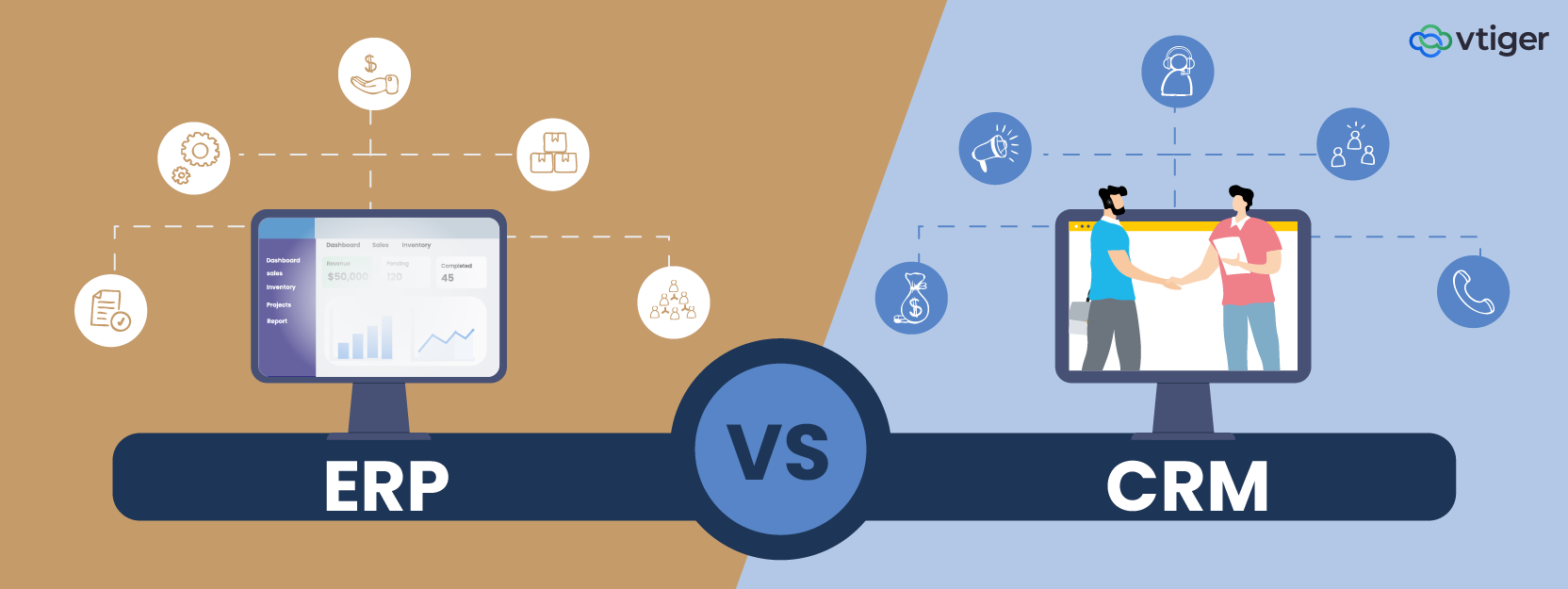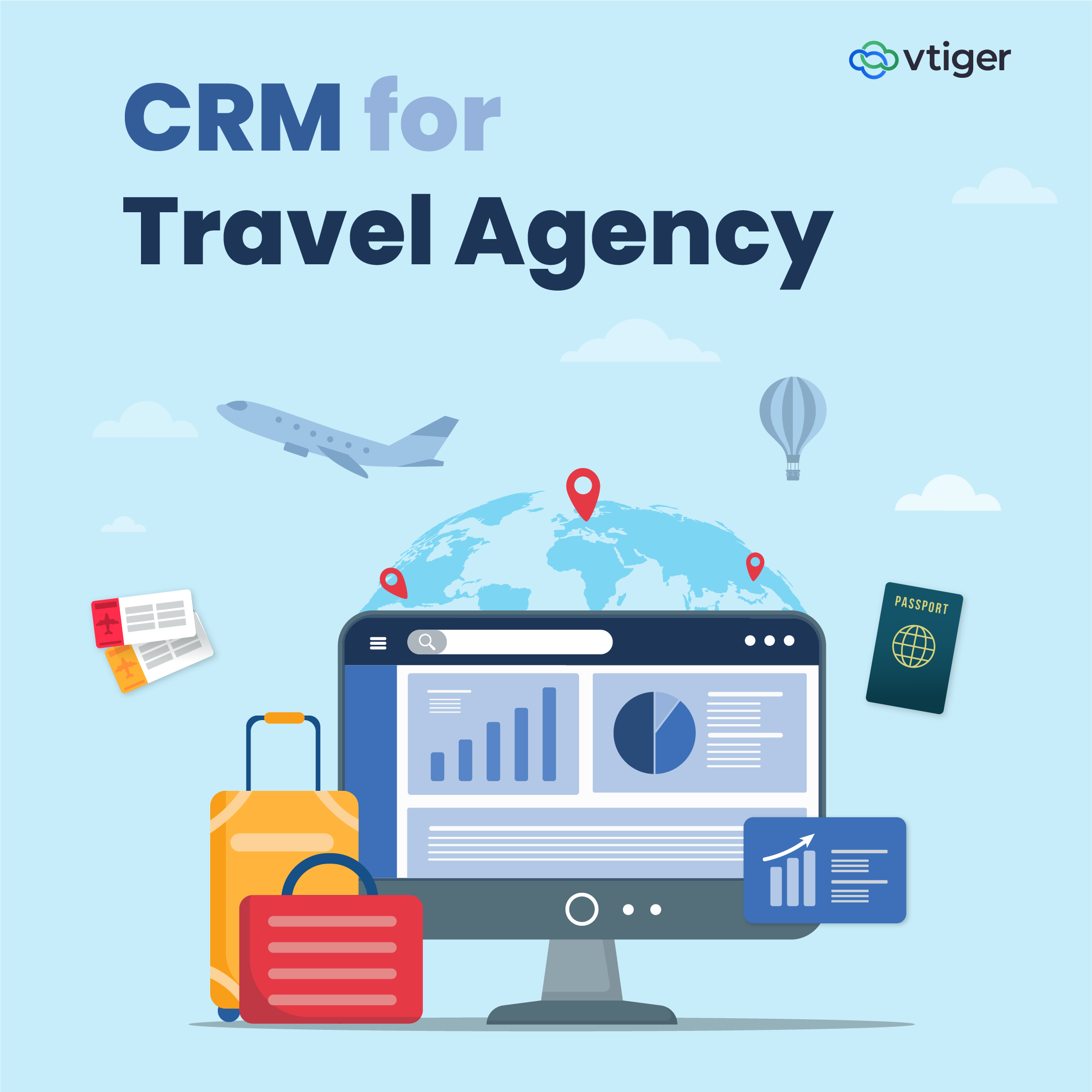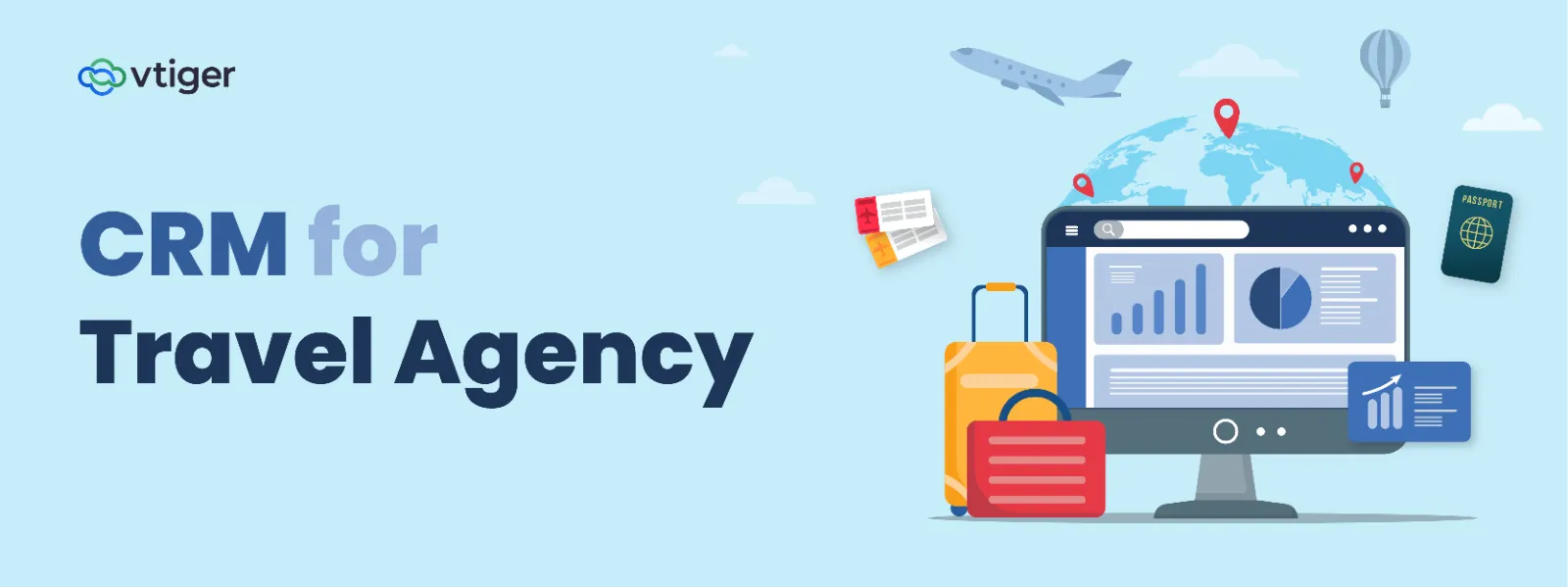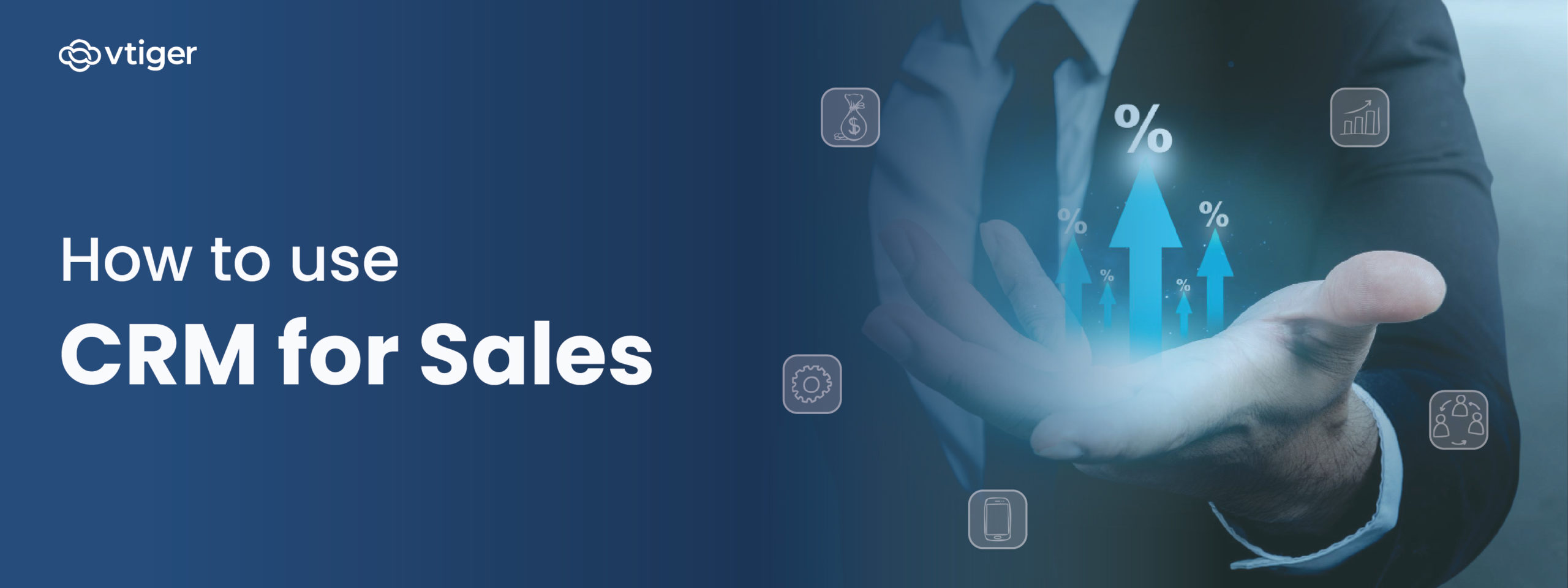The business world in the past decade has gone through a huge transition of automation, fast conflict resolution, and adopting KPI tracking to ensure efficient ROI on every tool they have invested in.
On one side, Enterprise Resource Planning (ERP) offers to transform your operations from the inside out; on the other, Customer Relationship Management (CRM) aims to help you create stronger, more loyal bonds with your customers.
Both systems are important for business growth, but they serve different purposes and solve different problems. When combined, they work together to improve efficiency and customer experience, making sure data moves smoothly from the warehouse to the sales floor without any major delays.
However, the question of “which system is better?” gives way to a more meaningful discussion: what are your business goals, and how will you operate these tools for growth, flexibility, and customer-centricity? Read this blog to find out.
What is Enterprise Resource Planning (ERP)?
Enterprise Resource Planning (ERP) is a business management solution designed to pull together every department, finance, HR, procurement, sales, and operations into a single system that everyone trusts. No more silos, no more “version chaos” between spreadsheets or apps. ERP systems automate and integrate essential functions, create a centralized hub for real-time data, and provide the leadership team with a dashboard reflecting organizational health.
What does this look like in real life? The finance team can use tools like integrated billing and real-time expense tracking to close monthly accounts much faster. The procurement team doesn’t have to rush around to reorder supplies. They get automatic low inventory alerts and accurate demand forecasts. HR can smoothly onboard new employees with step-by-step workflows while staying compliant with local rules. When all these processes work together, the company saves time, avoids errors, and cuts down on costs.
Core Purpose of an ERP System
- To harmonize and streamline business operations.
- To provide transparency, everyone from order processing to executive management has access to the same accurate data.
- To reduce repetitive work via process automation.
- To support growth by scaling with your business, it includes activities like adding new users, processes, or locations as you need, often with just a few clicks.
Benefits of Enterprise Resource Planning
The impact of ERP on business performance doesn’t just live in productivity metrics, it ripples through company culture, process effectiveness, and customer satisfaction.
- Centralized business data: Eliminate data isolation and keep everything, from invoices to inventory, stores, accessible, and continuously synchronized across departments.
- Improved operational efficiency: Routines and workflows are automated, saving time for your teams to work on true value-added tasks.
- Better inventory management: Always know what’s in stock, what’s running low, and what needs replenishing. This helps reduce waste while meeting customer demands on time.
- Real-time reporting and analytics: Make informed decisions with up-to-date data, whether you’re tracking month-end financials or daily sales trends.
- Cost savings through automation: Reduce manual errors and administrative costs, streamline procurement, and keep headcounts in check even as you grow.
- Regulatory compliance: Documentation and audit trails are automated, making compliance with industry standards and government regulations easier and less stressful.
- Scalable processes: As the business expands into new regions or markets, your ERP easily adapts to accommodate new products, services, or legal requirements.
- Improved collaboration: Colleagues from different teams work from one source of truth, minimizing misunderstandings or duplicated work.
One of the most celebrated features of ERP is how it “disappears” into the background, freeing your people to focus on the work that requires human creativity, strategic thinking, and genuine relationship-building.
What is Customer Relationship Management (CRM)?
Now let’s talk about what is CRM. Customer Relationship Management (CRM) is software designed for one purpose: to help you understand, nurture, and retain your customers. Where ERP works backstage, CRM puts your customers center stage, ensuring each interaction, right from the first website visit to a decade of loyalty, feels consistent and personal.
What does CRM bring to your business?
- Holistic View of Each Customer: Sales history, support tickets, marketing engagement, all at your fingertips.
- Proactive Pipeline Management: Track leads, opportunities, and deals with clarity.
- Tailored Marketing Campaigns: Segment your audience, automate outreach, and measure real ROI.
- Seamless Collaboration: Marketing, sales, and customer support teams all share the same view, making relevant data handoffs smooth, thereby reducing customer frustration.
- Data-driven Decision Making: Understand what messaging, channels, and products truly drive customer interest and satisfaction.
Typical CRM Functions
- Contact management: Store and organize details for every prospect and customer.
- Sales pipeline automation: Guide deals through each stage with reminders, workflow automations, and reporting.
- Marketing automation: Set up email sequences, track campaign engagement, and qualify leads instantly.
- Customer service ticketing: Empower your support teams to resolve issues promptly while keeping a record for future reference.
Benefits of Customer Relationship Management
Other than record-keeping, a CRM impacts multiple facets of a business. It links data points, communication threads, and customer behaviors that might otherwise stay hidden. The following list summarises the set of operational benefits a CRM can provide:
- Improved Customer Relationships: Every interaction is informed by history and preferences, making communications seamless and more relevant.
- Better Sales Tracking and Forecasting: Visual dashboards show the health of your pipeline and help teams spot opportunities or risks early.
- Enhanced Marketing Campaign Effectiveness: CRM analytics and segmentation let you run targeted, successful campaigns.
- Higher Customer Retention: Proactive follow-ups, loyalty programs, and responsive service keep customers coming back.
- Centralized Customer Communication: All teams, from web chat to field sales, see one unified record for every customer, preventing miscommunication and false promises.
- Faster response times: Automated alerts and streamlined workflows mean you’ll never drop the ball on a hot lead or open support ticket.
- Increased sales productivity: By automating mundane tasks and delivering insights, CRM helps sales reps focus on closing deals.
- Actionable insights: Real-time data pinpoints which products, messages, and services resonate most with your audience.
| Further Reading Suggestions | ||
| What is CRM | CRM Software | Mobile CRM |
| Open Source CRM | Sales CRM | AI CRM |
| Evolution of CRM | Analytical CRM | What is a Recruitment CRM |
| All-in-one CRM | Mobile CRM | What is the CRM Process |
Key Similarities between ERP and CRM
ERP and CRM serve different operational areas, yet they intersect in unexpected ways. Both capture and centralize data that would otherwise scatter across teams, revealing connections between processes, resources, and customer behavior:
1. Centralized Data Storage
Having all critical data in one place removes uncertainty, giving leaders confidence that decisions are based on accurate, up-to-date information.
2. Process Automation
Routine workflows run automatically, allowing teams to prioritize strategic initiatives, minimize errors, and maintain consistent performance under pressure.
3. Data-Driven Decision Making
Real-time dashboards and metrics transform guesswork into informed action, helping managers feel in control of growth and performance.
4. Scalability
Both platforms adapt as the organization expands, supporting more users, processes, and integrations so growth never stalls due to system constraints.
5. Collaboration Enablement
When departments operate with shared visibility and accountability, collaboration improves, reducing friction and enhancing team efficiency.
6. Cloud Accessibility
Access from any device keeps teams connected and responsive, ensuring operations continue smoothly, even across locations or remote setups.
Differences between ERP and CRM
ERP and CRM may seem similar because both centralize data, but their priorities and impacts differ. Recognizing these differences helps businesses decide which system addresses operational efficiency, customer growth, or both:
| Parameter | ERP | CRM |
| Core focus | Internal resources & operations (efficiency) | Customer-facing processes, sales, marketing, support |
| Primary users | Finance, HR, operations, manufacturing, supply | Sales, marketing, support, and customer success teams |
| Key modules/features | Accounting, procurement, inventory, payroll, compliance | Contact management, sales pipeline, marketing, helpdesk, automation |
| Implementation complexity | More complex and time-consuming; larger scale | Quicker to deploy, modular, and flexible |
| ROI focus | Cost savings, operational stability | Revenue growth, increased customer lifetime value |
| Customization | Customizes deep company workflows | Customizes user-facing messaging & workflows |
| Integration | May include CRM modules, but are not as deep | Typically integrates with ERP for a full business overview |
| Reporting | Financials, supply chain, logistics | Sales tracking, customer analytics, and marketing results |
Choosing between ERP vs CRM requires evaluating priorities. If operational consistency and cost control are the primary objectives, ERP delivers measurable outcomes through optimized workflows and process standardization. If growth, customer retention, and engagement are more pressing, CRM provides actionable insights, automation, and visibility into client behavior.
However, it is important to note that the highest value emerges when both systems are deployed strategically. ERP provides accurate operational and financial data that can guide sales forecasting, pricing decisions, and resource allocation. CRM captures customer behavior, engagement trends, and pipeline health, revealing opportunities for upselling, cross-selling, and retention.
With successful integration, these systems create a unified view across operations and customer touchpoints, enabling data-driven decision-making, reducing inefficiencies, aligning teams, and directly impacting revenue growth and long-term business sustainability.
Which is More Important: ERP or CRM?
There’s no universal answer; your priorities, pain points, and ambitions determine which comes first. Here’s how to think about it:
- Focusing on operational efficiency?
ERP gives leaders a clear view of core processes. Accounting is always up-to-date, procurement responds to production requirements, and inventory reflects stock levels across locations in real time. Teams can identify discrepancies early, adjust resources before delays occur, and monitor processes without waiting for periodic reports. This visibility transforms operations into proactive management and reduces the risk of inefficiencies.
- Prioritizing revenue and relationships?
CRM structures customer interactions into defined sequences. Leads are scored, follow-ups happen automatically, and account histories are accessible to all relevant team members. This approach highlights which interactions convert best and which opportunities need attention. Teams can optimize effort, tailor communications based on behavior, and maintain consistency in sales and service processes.
- Aiming for holistic growth?
Combining ERP and CRM systems creates a continuous flow of information. Operational data informs customer-facing teams about availability and delivery timelines. Customer insights indicate where processes may need adjustment to meet demand. This two-way feedback improves coordination, enhances decision-making, and supports growth across revenue, efficiency, and customer satisfaction.
Pros and Cons Chart
| Focus | Pros | Cons |
| ERP | Offers visibility into finance, procurement, and inventory simultaneously. Alerts teams to discrepancies before they escalate. Enables proactive management of resources and processes. | Setup requires careful planning. Focus remains internal. Teams need time to adapt. |
| CRM | Structure every customer interaction into clear sequences. Automates follow-ups and tracks account history across teams. Highlights high-value leads and engagement gaps. | Limited insight into internal operations. Success depends on consistent usage by the team. |
| ERP + CRM | Creates a two-way data loop connecting operations and customer-facing teams. Informs decisions with real-time insights. Supports growth across revenue, efficiency, and satisfaction. | Integration demands coordination. Costs and planning are higher. Requires alignment across departments. |
A software system is only as powerful as it fits with your business goals and culture. Reflect on what matters most today and where you dream of scaling tomorrow.
Can ERP and CRM Work Together?
Absolutely, and this collaboration can influence exponential business value. When ERP and CRM are integrated, your business operates as one synchronized ecosystem:
- Sales and marketing have visibility into inventory and fulfillment.
- Finance can match revenue from CRM directly to the correct budgets and invoices in ERP.
- Customer support and service teams have context about a customer’s purchase and delivery status.
- Executives can see a full “One View” of each customer and the entire business.
How is this integration accomplished?
- Shared databases: No more typing information twice. CRM and ERP sync customer profiles, order histories, and support cases automatically.
- API connections: Software “talks” through secure digital channels, updating both systems in real time. No manual exporting or importing.
- Automatic workflows: When a sale is closed in CRM, invoicing, and billing are triggered instantly in ERP.
Benefits:
- Fewer errors and delays, as information always matches across systems.
- More personalized customer service, support teams know a customer’s full journey, from lead to delivery.
- Faster, more transparent business cycles and a competitive edge.
Example:
A retail business uses its CRM to run targeted marketing campaigns, capture leads, and close sales. Once the deal closes, customer and order data flow instantly to the ERP, updating inventory, generating an invoice, and even alerting the shipping department. If there’s an issue, support can see everything without needing to ask the customer to repeat themselves. In short: Integration is where business software stops being a “tool” and becomes a growth engine.
Factors to Consider Before Choosing ERP or CRM
Selecting between ERP and CRM requires more than comparing features. It demands evaluating how each system aligns with your business priorities, processes, and long-term objectives.
Business Size and Operational Complexity
Smaller teams with a high proportion of customer-facing staff benefit more quickly from CRM, as it structures interactions, tracks leads, and automates follow-ups. Organizations with multi-location operations, supply chain dependencies, or complex internal workflows may see higher impact from ERP, which provides visibility into resource allocation, process bottlenecks, and compliance.
Budget and Expected Returns
Short-term costs must be weighed against potential operational or revenue gains. CRM adoption often delivers quicker wins through increased conversion rates and improved customer retention. ERP investment typically requires longer planning cycles but delivers measurable efficiency, compliance, and cost control benefits at scale.
Industry-Specific Needs and Compliance
Businesses in regulated sectors, such as healthcare and finance, require ERP modules to ensure compliance, auditability, and accurate reporting. CRMs excel where customer engagement, personalization, and multi-channel interaction tracking are central to growth.
Integration and Future Scalability
Consider how your chosen system interacts with existing tools like payroll, marketing automation, or e-commerce platforms. ERP and CRM both gain value from integration, but planning is crucial to ensure workflows between internal operations and customer-facing teams remain uninterrupted.
Vendor Support and Implementation Strategy
Implementation is rarely plug-and-play. Evaluate vendor support, training resources, and ecosystem partners. A system that aligns with your team’s capability and offers ongoing assistance reduces adoption friction and accelerates return on investment.
Future Trends in ERP and CRM
As digital transformation gathers speed, ERP and CRM are evolving to become even more valuable, flexible, and intuitive. Here’s what’s on the horizon:
AI and Machine Learning
In ERP, AI predicts inventory shortages, production delays, or financial risks. In CRM, it identifies high-potential leads, recommends follow-up actions, and anticipates customer churn. Teams get actionable insights instead of raw data.
Mobile-First Access
ERP users can approve purchase orders or monitor supply chains from any device. CRM teams can update contact records, log client interactions, and respond to inquiries instantly. Real-time access keeps operations and customer touchpoints aligned.
Cloud-Based Solutions
ERP modules for finance, inventory, and HR scale automatically with business growth. CRM modules for sales, marketing, and support expand without major IT effort. Cloud systems reduce implementation delays and allow seamless cross-location collaboration.
Predictive Analytics
ERP dashboards highlight upcoming operational bottlenecks or cash flow risks. CRM dashboards forecast sales trends, campaign outcomes, and customer engagement patterns. This ensures planning is proactive rather than reactive.
Integration Ecosystems
ERP integrates with procurement, manufacturing, and accounting systems to centralize operational workflows. CRM connects with marketing, customer support, and sales tools for consistent communication. Integrated platforms eliminate data silos and enable coordinated strategies.
The future belongs to businesses that embrace continual learning, where software not only supports but actively guides your growth journey.
Closing Note: Why Vtiger CRM?
At Vtiger, we know that the best business is built on trust, teamwork, and clear data. With a CRM that combines marketing, sales, and support into a single AI-powered platform, you’ll never have to guess where your next opportunity lies—or how to delight a customer. We help you turn every interaction into growth, every challenge into insight, and every day into a chance to build stronger, lasting relationships.
FAQs about ERP vs CRM
ERP is inward-facing, designed to streamline processes like finance, procurement, and operations. CRM is outward-facing, focusing on managing leads, customer interactions, and improving engagement across sales, marketing, and support.
Yes. Small businesses often start with CRM to manage relationships and then adopt ERP modules as operational complexity grows. Cloud-based solutions, like Vtiger CRM, scale without major IT investment.
ERP systems generally carry higher costs due to wider functionality and longer deployment timelines. CRM solutions are often faster to implement and more affordable, especially for small to mid-sized teams.
Many ERP platforms include basic CRM functions, such as contact management and customer invoicing. Dedicated CRMs offer deeper capabilities for managing interactions, campaigns, and service workflows.
No. CRM data benefits marketing, customer support, and product teams, ensuring everyone has a consistent view of customer engagement and history.
Cloud-based CRMs can be deployed in weeks, while ERP setups typically require several months for configuration, training, and process alignment across departments.
Absolutely. Integrating ERP and CRM reduces data errors, accelerates workflows, and provides a single view of operations and customer interactions.
CRM. It captures every interaction, logs support requests, and equips service teams to resolve issues promptly while maintaining consistent communication.
Yes, but modern platforms, including Vtiger CRM, offer intuitive interfaces, tutorials, and support to make onboarding straightforward and adoption faster.



